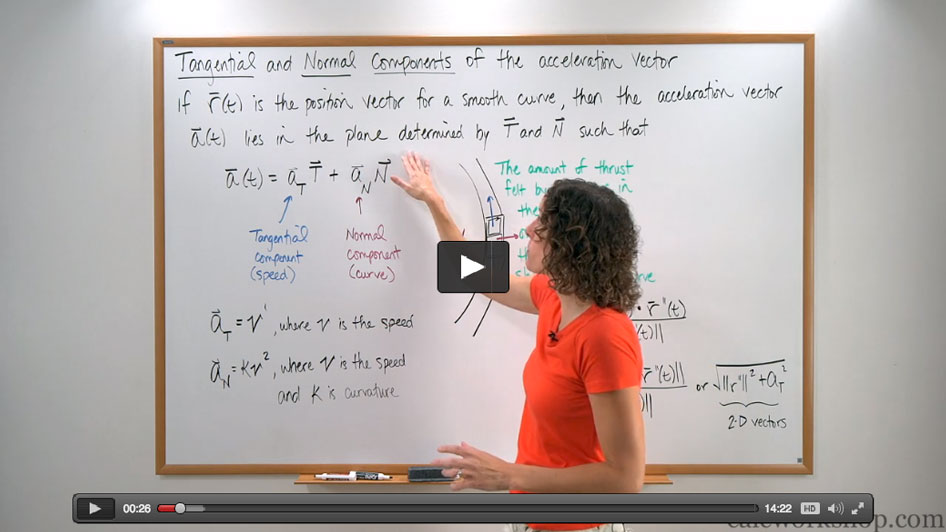When dealing with physical applications of vectors, such as the design of a rocket engine, it’s essential to understand how acceleration acts in any direction.

Jenn, Founder Calcworkshop®, 15+ Years Experience (Licensed & Certified Teacher)
Therefore, it is sometimes helpful to describe its motion using normal and tangential components or the N-T coordinate system.
It may be helpful to think of acceleration as a vector — therefore, it can be broken down into two components:
- Tangential Component of Acceleration
- Normal Component of Acceleration
\begin{equation}
\vec{a}=a_{T} \vec{T}+a_{N} \vec{N}
\end{equation}
Tangential Component
The tangential component is tangent to the curve and in the direction of increasing or decreasing velocity and is denoted as \(a_{T}\), and allows us to know how much acceleration acts in the direction of motion.
Normal Component
The normal component, sometimes called the centripetal component, is always directed toward the center of curvature of the curve and is denoted as \({a_N}\), and allows us to know how much the acceleration is orthogonal to the tangential acceleration.
Therefore, if the acceleration vector is written as \(\vec{a}=a_{T} \vec{T}+a_{N} \vec{N}\), then
\begin{equation}
a_{T}=\frac{d^{2} s}{d t^{2}}=\frac{\vec{r}^{\prime}(t) \cdot \vec{r}^{\prime \prime}(t)}{\left\|\vec{r}^{\prime}(t)\right\|} \text { and } a_{N}=\kappa\left(\frac{d s}{d t}\right)^{2}=\frac{\left\|\vec{r}^{\prime}(t) \times \vec{r}^{\prime \prime}(t)\right\|}{\left\|\vec{r}^{\prime}(t)\right\|}
\end{equation}
Example
For instance, let’s find the tangential and normal components of the acceleration vector of a particle with position function \(\vec{r}(t)=\left\langle t, 2 t, t^{2}\right\rangle\).
Step 1:
First, we will find both the velocity vector, \(\vec{r}^{\prime}(t)\), and acceleration vector, \(\vec{r}^{\prime \prime}(t)\).
\begin{equation}
\begin{aligned}
&\vec{r}^{\prime}(t)=\langle 1,2,2 t\rangle \\
&\vec{r}^{\prime \prime}(t)=\langle 0,0,2\rangle
\end{aligned}
\end{equation}Step 2:
Next, we will find the magnitude of the velocity vector \(\left\|\vec{r}^{\prime \prime}(t)\right\|\).
\begin{equation}
\left\|\vec{r}^{\prime}(t)\right\|=\sqrt{1^{2}+2^{2}+(2 t)^{2}}=\sqrt{5+4 t^{2}}
\end{equation}Step 3:
Now we will calculate both the dot product \(\vec{r}^{\prime}(t) \cdot \vec{r}^{\prime \prime}(t)\) and the magnitude of the cross product \(\vec{r}^{\prime}(t) \times \vec{r}^{\prime \prime}(t)\).
\begin{equation}
\begin{aligned}
&\vec{r}^{\prime}(t) \cdot \vec{r}^{\prime \prime}(t)=\langle 1,2,2 t\rangle \cdot\langle 0,0,2\rangle=4 t \\
&\vec{r}^{\prime}(t) \times \vec{r}^{\prime \prime}(t)=\left|\begin{array}{ccc}
\vec{i} & \vec{j} & \vec{k} \\
1 & 2 & 2 t \\
0 & 0 & 2
\end{array}\right|=\langle 4,-2,0\rangle \\
&\left\|\vec{r}^{\prime}(t) \times \vec{r}^{\prime \prime}(t)\right\|=\sqrt{4^{2}+(-2)^{2}+0^{2}}=\sqrt{20}=2 \sqrt{5}
\end{aligned}
\end{equation}Step 4:
Lastly, we drop everything into our tangential and normal component formulas.
\begin{equation}
a_{T}=\frac{\vec{r}^{\prime}(t) \cdot \vec{r}^{\prime \prime}(t)}{\left\|\vec{r}^{\prime}(t)\right\|}=\frac{4 t}{\sqrt{5+4 t^{2}}} \text { and } a_{N}=\frac{\left\|\vec{r}^{\prime}(t) \times \vec{r}^{\prime \prime}(t)\right\|}{\left\|\vec{r}^{\prime}(t)\right\|}=\frac{2 \sqrt{5}}{\sqrt{5+4 t^{2}}}
\end{equation}
Nothing to it!
And did you know that tangential acceleration and the normal acceleration help us to better understand planetary motion?
Yep!
The three laws of planetary motion, commonly known as Kepler’s Laws, and Newton’s laws of motion, utilize the acceleration vector to explain elliptical orbits and gravitation.
Cool.
So, together we will take a closer look at the velocity and acceleration vectors, analyze the speed of a particle given the position function, and see how the tangent and normal vectors, along with curvature and arc length, can be used to study the motion of an object in space.
So, let’s get to it!
Video Tutorial w/ Full Lesson & Detailed Examples (Video)

Get access to all the courses and over 450 HD videos with your subscription
Monthly and Yearly Plans Available
Still wondering if CalcWorkshop is right for you?
Take a Tour and find out how a membership can take the struggle out of learning math.